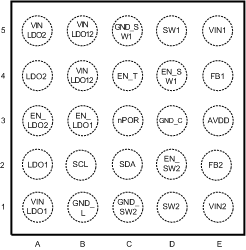SNVSA28 December 2014 LP8731-Q1
PRODUCTION DATA.
- 1 Features
- 2 Applications
- 3 Description
- 4 Revision History
- 5 Device Comparison Tables
- 6 Pin Configuration and Functions
-
7 Specifications
- 7.1 Absolute Maximum Ratings
- 7.2 ESD Ratings
- 7.3 Recommended Operating Conditions (Bucks)
- 7.4 Thermal Information
- 7.5 General Electrical Characteristics
- 7.6 Low Dropout Regulators, LDO1 And LDO2
- 7.7 Buck Converters SW1, SW2
- 7.8 I/O Electrical Characteristics
- 7.9 Power-On Reset Threshold/Function (POR)
- 7.10 I2C-Compatible Interface Timing
- 7.11 Typical Characteristics
-
8 Detailed Description
- 8.1 Overview
- 8.2 Functional Block Diagram
- 8.3
Features Description
- 8.3.1 Linear Low Dropout Regulators (LDOs)
- 8.3.2 No-Load Stability
- 8.3.3 LDO1 and LDO2 Control Registers
- 8.3.4
SW1, SW2: Synchronous Step-Down Magnetic DC-DC Converters
- 8.3.4.1 Functional Description
- 8.3.4.2 Circuit Operation
- 8.3.4.3 PWM Operation
- 8.3.4.4 Internal Synchronous Rectification
- 8.3.4.5 Current Limiting
- 8.3.4.6 SW1, SW2 Operation
- 8.3.4.7 SW1, SW2 Control Registers
- 8.3.4.8 Shutdown Mode
- 8.3.4.9 Soft Start
- 8.3.4.10 Low Dropout Operation
- 8.3.4.11 Flexible Power Sequencing of Multiple Power Supplies
- 8.3.4.12 Power-Up Sequencing Using the EN_T Function
- 8.3.5 Flexible Power-On Reset (for example, Power Good with Delay)
- 8.3.6 Undervoltage Lockout
- 8.4 Device Functional Modes
- 8.5 Programming
- 8.6
LP8731-Q1 Register Maps
- 8.6.1 Interrupt Status Register (ISRA) 0x02
- 8.6.2 System Control 1 Register (SCR1) 0x07
- 8.6.3 EN_DLY Preset Delay Sequence after EN_T Assertion
- 8.6.4 Buck and LDO Output Voltage Enable Register (BKLDOEN) - 0x10
- 8.6.5 Buck and LDO Status Register (BKLDOSR) - 0x11
- 8.6.6 BUCK Voltage Change Control Register 1 (VCCR) - 0x20
- 8.6.7 BUCK1 Target Voltage 1 Register (B1TV1) - 0x23
- 8.6.8 BUCK1 Target Voltage 2 Register (B1TV2) - 0x24
- 8.6.9 BUCK1 Ramp Control Register (B1RC) - 0x25
- 8.6.10 BUCK2 Target 1 Register (B2TV1) - 0x29
- 8.6.11 BUCK2 Target 2 Register (B2TV2) - 0x2A
- 8.6.12 BUCK2 Ramp Control Register (B2RC) - 0x2B
- 8.6.13 BUCK Function Register (BFCR) - 0x38
- 8.6.14 Spread Spectrum Function
- 8.6.15 LDO1 Control Register (LDO1VCR) - 0x39
- 8.6.16 LDO2 Control Register (LDO2VCR) - 0x3A
- 9 Application and Implementation
- 10Power Supply Recommendations
- 11Layout
- 12Device and Documentation Support
- 13Mechanical, Packaging, and Orderable Information
6 Pin Configuration and Functions
DSBGA (YZR) Package
25 Pins
Top View

Pin Functions
| PIN | I/O | TYPE | DESCRIPTION | |
|---|---|---|---|---|
| NUMBER | NAME | |||
| A1 | VINLDO1 | I | PWR | VINLDO1 power in from either DC source or battery to input pin to LDO1. |
| A2 | LDO1 | O | PWR | LDO1 Output |
| A3 | ENLDO2 | I | D | LDO2 enable pin, a logic HIGH enables the LDO2 |
| A4 | LDO2 | O | PWR | LDO2 Output |
| A5 | VINLDO2 | I | PWR | VINLDO2 power in from either DC source or battery to input pin to LDO2. |
| B1 | GND_L | G | G | LDO ground |
| B2 | SCL | I | D | I2C Clock |
| B3 | ENLDO1 | I | D | LDO1 enable pin, a logic HIGH enables the LDO1 |
| B4, B5 | VINLDO12 | I | PWR | Analog power for internal functions (VREF, BIAS, I2C, Logic) |
| C1 | GND_SW2 | G | G | Buck2 NMOS Power ground |
| C2 | SDA | I/O | D | I2C Data (bidirectional) |
| C3 | nPOR | O | D | nPOR power-on reset pin for both Buck1 and Buck2. Open drain logic output 100K pull-up resistor. nPOR is pulled to ground when the voltages on these supplies are not good. See Flexible Power-On Reset (for example, Power Good with Delay) section for more info. |
| C4 | EN_T | I | D | Enable for preset power-on sequence. (See Flexible Power-On Reset (for example, Power Good with Delay).) |
| C5 | GND_SW1 | G | G | Buck1 NMOS power ground |
| D1 | SW2 | O | PWR | Buck2 switcher output pin |
| D2 | ENSW2 | I | D | Enable pin for Buck2 switcher, a logic HIGH enables Buck2 |
| D3 | GND_C | G | G | Non-switching core ground pin |
| D4 | ENSW1 | I | D | Enable pin for Buck1 switcher, a logic HIGH enables Buck1 |
| D5 | SW1 | O | PWR | Buck1 switcher output pin |
| E1 | VIN2 | I | PWR | VIN2 power in from either DC source or Battery to Buck2 |
| E2 | FB2 | I | A | Buck2 input feedback pin |
| E3 | AVDD | I | PWR | Analog Power for Buck converters |
| E4 | FB1 | I | A | Buck1 input feedback pin |
| E5 | VIN1 | I | PWR | VIN1 power in from either DC source or Battery to Buck1 |
| A: Analog Pin; D: Digital Pin; G: Ground Pin; PWR: Power Pin; I: Input Pin; O: Output Pin; I/O: Input/Output Pin | ||||